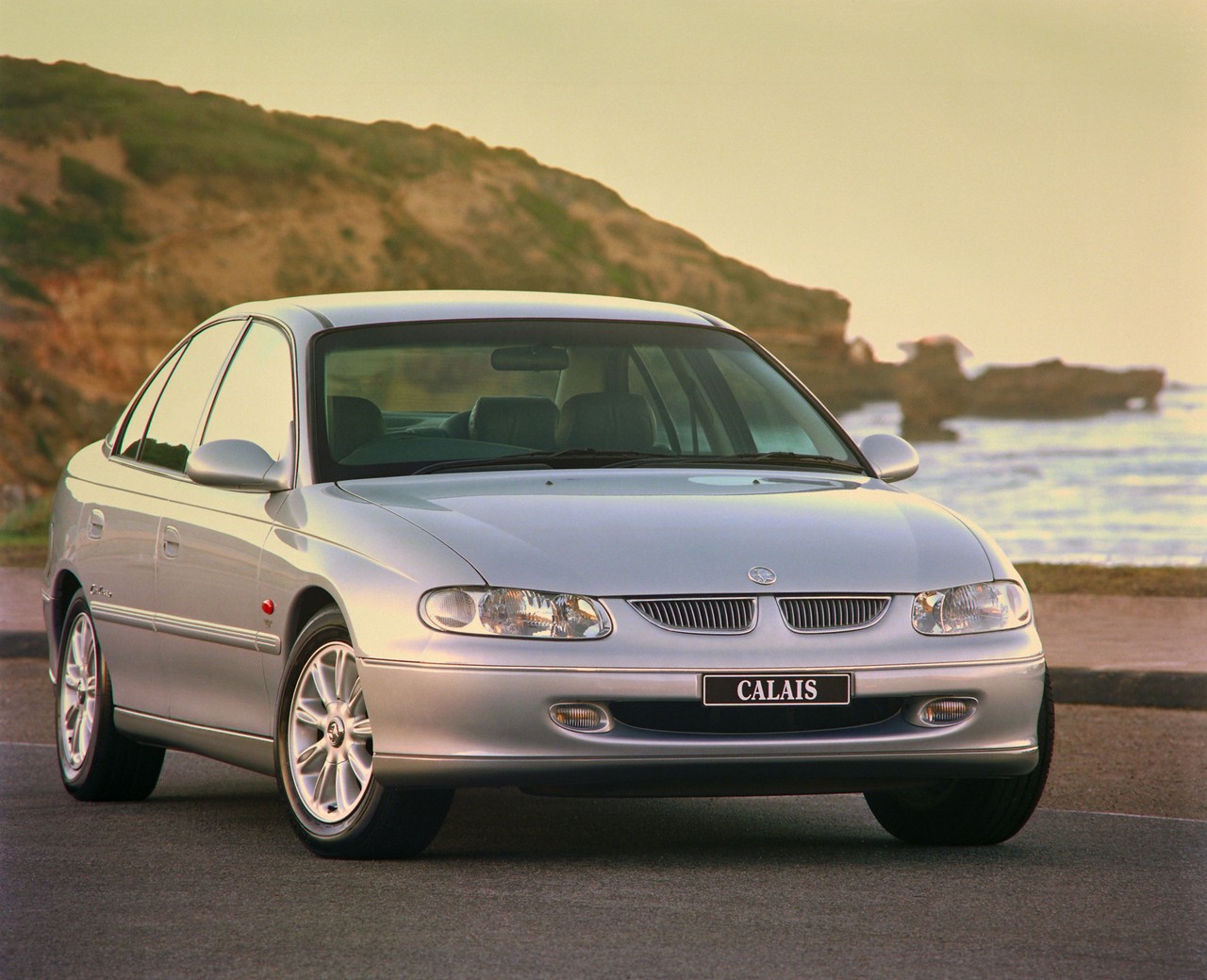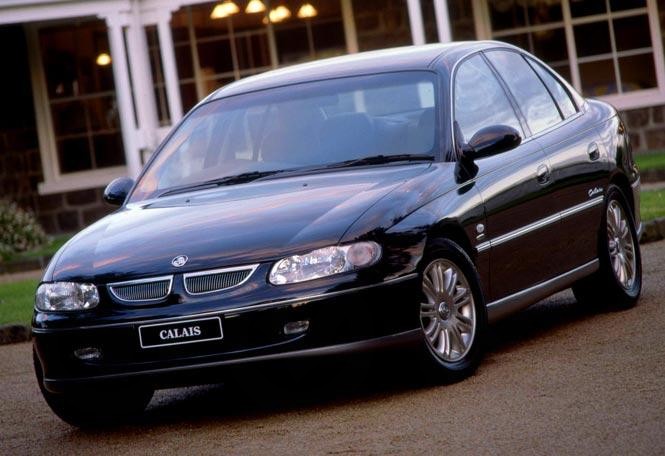
- Economical 3.8-litre L36 V6 engine
- Spacious and comfortable interior
- Accomplished ride/handling balance
- Quiet, well-insulated cabin
- V6 engine coarse above 3000 rpm
- Clunky downshifts for automatic transmission
- Vague steering lacks feel
- Low standard of interior fit and finish
- Poor build quality for 5.7-litre LS1 V8 engine
- No toe control links for rear suspension (introduced in VX.II Calais)
Holden VT.I Calais (1997-99)
Overview
Released in August 1997, the Holden VT Series I (VT.I) Calais was a large sedan. Manufactured in Elizabeth, South Australia, the rear-wheel drive VT.I Calais was available with 3.8-litre V6, supercharged 3.8-litre V6 and 5.0-litre V8 petrol engines.
Engines: V6, Supercharged V6 and V8
Of the engines,
- The 3.8-litre L36 pushrod V6 petrol engine had a cast iron block and cylinder head, multi-port fuel injection, two valves per cylinder, a single balance shaft and a compression ratio of 9.4:1. For the VT range, the L36 engine was fitted with an updated injection fuel system to reduce emissions;
- The 3.8-litre L67 supercharged V6 engine was based on the L36 engine but distinguished by its Eaton M90 supercharger (which provided boost pressure of 6 psi or 0.41 bar), fuel injectors, cylinder heads and lower intake manifold; the compression ratio was also lowered to 8.5:1; and,
- The 5.0-litre LB9 pushrod V8 engine had a cast iron block, two valves per cylinder, multi-point fuel injection and a compression ratio of 8.4:1. To comply with new emissions standards, changes for the VT generation were made to the cylinder heads, pistons, camshaft, throttle body, air intake and exhaust systems.
All engines were mated to four-speed 4L60E automatic transmissions.
Development and dimensions
Jointly developed with the VT Commodore as part of a $600 million program, the VT sedans were based on an extended and strengthened GM2800 platform which also underpinned the Opel Omega B. Compared to its VS Calais predecessor, the VT Calais was 23 mm longer (at 4884 mm), 48 mm wider (1842 mm), 47 mm taller (1450 mm) and had a 57 mm longer wheelbase (2788 mm).
Suspension
The VT Calais had MacPherson strut front and independent rear suspension with semi-trailing arms (albeit without toe control links).
| Engine | Trans. | Peak power | Peak torque |
|---|---|---|---|
| 3.8-litre L36 petrol V6 | 4sp auto | 147 kW at 5200 rpm | 304 Nm at 3600 rpm |
| 3.8-litre L67 s/charged petrol V6 | 4sp auto | 171 kW at 5200 rpm | 375 Nm at 3000 rpm |
| 5.0-litre LS1 petrol V8 | 4sp auto | 179 kW at 4800 rpm | 400 Nm at 3600 rpm |
Safety equipment
Standard safety equipment for the VT.I Calais included dual front airbags, ABS, front seatbelt pretensioners and anti-submarining seat ramps; V6 models were also fitted with traction control.
Brakes
The VT Calais had 296 mm by 28 mm vented front brake discs with twin-piston calipers and 286 mm by 16 mm solid rear brake discs with single piston calipers.
Features
Standard VT Calais features included 16-inch alloy wheels, an eight speaker sound system with 10-disc CD player, dual zone climate control air conditioning, power adjustable front seats, cruise control, front fog lights, ‘twilight sentinel’headlights (i.e. automatic shut-down), ‘PowerKey’system with driver’s memory settings, a leather-wrapped steering wheel, remote central locking, power mirrors and windows, a height and reach adjustable steering wheel, trip computer and an immobiliser.
1998 Holden Calais 50th Anniversary
In June 1998, a limited-run 50th Anniversary edition was released. Available with the 3.8-litre V6 engines – both naturally aspirated and supercharged – the 50th Anniversary edition was distinguished by its standard front side airbags, special alloy wheels, leather seats, Satin Gold paint finish and 50th Anniversary badging.
Holden VT.II Calais (1999-00)
Overview
Released in June 1999, the Holden VT Series II (VT.II) Calais introduced improved equipment levels and a new V8 engine as the 5.0-litre V8 was replaced by GM’s 5.7-litre ‘Generation III’ LS1 engine (described below). Although the 3.8-litre supercharged V6 engine was standard for the VT.II Calais, its naturally aspirated counterpart could also be specified.
Visually, the VT.II Calais could be identified by its chrome window surrounds, new alloy wheel designs and a chrome strip on the boot garnish; inside, there was an updated instrument panel with transmission indicator display. The suspension was also revised as tyre size increased from 215/60 R16 to 225/55 R16.
5.7-litre LS1 V8 engine
The 5.7-litre LS1 pushrod V8 engine had all-aluminium construction, a 99 mm bore, 92 mm stroke, sequential multi-port fuel injection, flat-topped pistons, two valves per cylinder, twin knock control sensors, a compression ratio of 10.1:1 and a 6000 rpm redline. Furthermore, the LS1’s aluminium cylinder block assembly weighed 48.85 kg, resulting in a 40 kg weight saving relative to its 5.0-litre, cast-iron predecessor. Like other engines in the VT.II Calais range, the LS1 engine was mated to the four-soeed 4L60E automatic transmission.
| Engine | Trans. | Peak power | Peak torque |
|---|---|---|---|
| 3.8-litre L36 petrol V6 | 4sp auto | 147 kW at 5200 rpm | 304 Nm at 3600 rpm |
| 3.8-litre L67 s/charged petrol V6 | 4sp auto | 171 kW at 5200 rpm | 375 Nm at 3000 rpm |
| 5.7-litre LS1 petrol V8 | 4sp auto | 220 kW at 5000 rpm | 446 Nm at 4400 rpm |
Safety equipment
Compared to its VT.I predecessor, safety equipment for the VT.II Calais was improved with front seat-mounted side airbags with thorax and head protection fitted as standard; the 5.7-litre V8 was also fitted with traction control (previously limited to the V6 models).
Features
Standard features were also improved with the introduction of a ten speaker sound system, remote central deadlocking, remote approach lighting (activated by pressing ‘unlock’ on the key fob), a disabling function for the power-operated boot release, a ‘key off’ courtesy lamp and ‘battery saver’function which automatically shut down any lights after 60 minutes of inactivity.
2000 Holden Calais International
In February 2000, a limited-run International edition was released. Powered by the 3.8-litre supercharged V6 engine, the Calais International was distinguished by its 17-inch alloy wheels with low profile tyres (235/45), two-tone interior trim combination with shale-coloured Howe leather seats and pewter-coloured soft trim, mid-grey instrument cluster with satin silver surrounds and textured metallic finishes for the fascia and console. The Calais International was solely available with a Grey Storm (i.e. dark charcoal metallic) paint finish.
Related links




